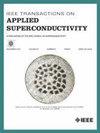An Updated Cylindric Linear-Motor Type Flux Pump With Rapid Current Variation Capability
IF 1.7
3区 物理与天体物理
Q3 ENGINEERING, ELECTRICAL & ELECTRONIC
引用次数: 0
Abstract
In comparison to traditional DC power supplies, linear-motor type flux pumps present a number of advantages, including a reduction in dimensions, a lower cost, and decrease in energy consumption. Therefore, it is useful to use a flux pump to power superconducting magnets in a non-contact manner. In order to facilitate the rapid excitation and current modulation of superconducting magnets updated flux pump was designed to deliver a higher DC voltage output. The distribution of magnetic flux density was analyzed using COMSOL Multiphysics, which helped in determining the optimal design parameters. We extended the coupling interval of the updated flux pump to 447 mm. The updated flux pump was tested at 77 K in liquid nitrogen, with a maximum output voltage of 118.24 mV, the updated flux pump can charge an insulated (INS) double pancake coil (DPC) with 75 turns per layer to a maximum current of 88.90 A in 9 s, exceeding the critical current (一种具有快速电流变化能力的新型圆柱形直线电机磁通泵
与传统的直流电源相比,直线电机型磁通泵具有许多优点,包括尺寸减小、成本降低和能耗降低。因此,利用磁通泵以非接触方式为超导磁体提供动力是有用的。为了方便超导磁体的快速激励和电流调制,设计了新型磁通泵,以提供更高的直流电压输出。利用COMSOL Multiphysics软件对磁通密度分布进行了分析,确定了优化设计参数。我们将更新后的通量泵的耦合间隔延长到447 mm。改进后的磁通泵在液氮中77 K的温度下进行了测试,最大输出电压为118.24 mV,改进后的磁通泵可以在9 s内为绝缘(INS)双烧饼线圈(DPC)充电,每层75匝,最大电流为88.90 a,超过了DPC的临界电流(${I}_{C}$)。这种更新的磁通泵可以为超导电机,磁共振成像(MRI)和其他设备的超导转子提供动力。本研究验证了延长耦合长度可以有效提高磁通泵的输出电压,对直线电机型磁通泵的应用具有深远的影响。
本文章由计算机程序翻译,如有差异,请以英文原文为准。
求助全文
约1分钟内获得全文
求助全文
来源期刊

IEEE Transactions on Applied Superconductivity
工程技术-工程:电子与电气
CiteScore
3.50
自引率
33.30%
发文量
650
审稿时长
2.3 months
期刊介绍:
IEEE Transactions on Applied Superconductivity (TAS) contains articles on the applications of superconductivity and other relevant technology. Electronic applications include analog and digital circuits employing thin films and active devices such as Josephson junctions. Large scale applications include magnets for power applications such as motors and generators, for magnetic resonance, for accelerators, and cable applications such as power transmission.
 求助内容:
求助内容: 应助结果提醒方式:
应助结果提醒方式:


